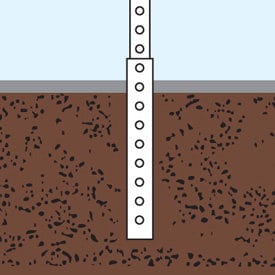Court Finds Strongly in City’s Favor in San Diego Slip & Fall Case
We’ve walked by them hundreds of times, maybe even noticed them before – the bases of street signs. Usually they consist of a larger piece of pipe embedded into the sidewalk into which the signpost slides. (See photo) Take a look the next time you see a sign.
For Mr. Heskel, he’ll probably be noticing these for the rest of his life.
On a late September evening in 2009, Mr. Heskel and his son Danny were out for a walk in San Diego. They were on the sidewalk. To Mr. Heskel’s great misfortune, the area was not well-lit and someone had removed a street sign from the sidewalk, leaving only the base embedded into the concrete. Not seeing the base, which was protruding “several inches,” he tripped over it, injured his back and broke his left wrist. There was nothing to alert Mr. Heskel’s attention to the pipe protruding from the sidewalk. It was not blocked off nor was it painted a bright, contrasting color.
Because they were the owners and controllers of the property, Mr. Heskel filed a complaint against the City of San Diego.
The law, as it relates to premises liability, is as follows:
To establish this claim, of premises liability plaintiff must prove all of the following:
- That defendant owned/leased/occupied/controlled the property;
- That defendant was negligent in the use or maintenance of the property;
- That plaintiff was harmed; and
- That defendant’s negligence was a substantial factor in causing plaintiff’s harm.
CACI Jury Instruction No. 1000
There wasn’t much of a question that the city of San Diego owned and controlled the property where Mr. Heskel was injured. There was no question that Mr. Heskel was injured. The question for the court became one of whether the city was negligent in the maintenance of their property. Ultimately, it became a question of notice. Notice is determined as follows:
In determining whether defendant should have known of the condition that created the risk of harm, you must decide whether, under all the circumstances, the condition was of such a nature and existed long enough that defendant had sufficient time to discover it and, using reasonable care:
- Repair the condition; or
- Protect against harm from the condition; or
- Adequately warn of the condition.
Defendant must make reasonable inspections of the property to discover unsafe conditions. If an inspection was not made within a reasonable time before the accident, this may show that the condition existed long enough so that a city using reasonable care would have discovered it.
CACI Jury Instruction No. 1011
Mr. Heskel introduced sworn statements of three individuals to show that the City of San Diego had notice of the dangerous condition posed by the protruding signpost.
One such statement was by another gentleman whom had tripped over the pipe “well over one year before” Heskel’s incident and that the city had quickly placed a “No Parking” sign in the pipe shortly after his fall.
Danny Heskel, who witnessed his father’s fall, provided testimony that the area around the pipe was painted a different color shortly after his father’s fall and confirmed that a sign was placed in the pipe shortly thereafter as well.
Another gentleman provided sworn testimony that he regularly worked in the area and that the pipe had been protruding from the sidewalk for “about 2 years.” He further testified that, prior to the sign being placed in the pipe, he had driven his truck on the sidewalk and punctured a tire due to the protrusion.
All of this testimony seems to raise, at the very least, a triable issue of fact as to the City’s liability right?
Not according to the Superior Court or the Appellate Court.
The appellate court concluded that the city carried its burden to demonstrate plaintiff lacked evidence as to the essential element of obviousness.
While plaintiff’s evidence suggested that the condition was above ground and visible, it did not demonstrate that it was of a substantial size or so visible from public thoroughfares that the city, in the exercise of due care, should have become aware of it and taken corrective action to cure it.
Because Mr. Heskel, in the Court’s opinion, failed to present any evidence that the condition was obvious such that the city, in the exercise of due care, should have become aware of it, his claim failed as a matter of law, notwithstanding his evidence that the condition was present for over one year before his accident.
It is very unfortunate that the Court has ruled in the City’s favor. It seems clear to me that, having been present for as much as 2 years (according to one declaration), the city had more than ample opportunity to discover this dangerous protrusion and make the changes necessary to ensure that its residents are safe. Clearly, once Mr. Heskel injured himself, the City wasted no time in fixing the problem.
If you are injured on public property, it is very important that you do not delay in presenting your claim. Claims against public entities in California must be made within 6 months.
We at Heiting & Irwin have decades of experience in presenting public entity claims and representing those injured on both public and private property.
The case referred to in this article is: Heskel v. City of San Diego, 227 Cal. App. 4th 313

